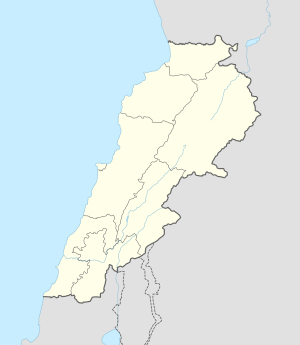 | |
| Geographical range | Lebanon |
|---|---|
| Period | Epipaleolithic |
| Dates | circa 10,200 B.C.E. — circa 8,800 B.C.E. |
| Type site | Qaa, Maqne |
| Major sites | Hermel, Kamouh el Hermel, Douris, Hermel, Kamouh el Hermel, Qalaat Tannour, Rayak North, Riha Station |
| Preceded by | Natufian culture |
| Followed by | Pre-Pottery Neolithic A |
Shepherd Neolithic is a name given by archaeologists to a style (or industry) of small flint tools from the Hermel plains in the north Beqaa Valley, Lebanon.[1]
Map of Lebanon showing important sites that were occupied in the Shepherd Neolithic (clickable map)
| The Stone Age |
|---|
| ↑ before Homo (Pliocene) |
|
| ↓ Chalcolithic |
The Shepherd Neolithic industry has been insufficiently studied and was provisionally named based on a limited typology collected by Jesuit archaeologist "Père" Henri Fleisch.[2] Lorraine Copeland and Peter J. Wescombe suggested it was possibly "of quite late date".[2]

- ^ Fleisch, Henri., Les industries lithiques récentes de la Békaa, République Libanaise, Acts of the 6th C.I.S.E.A., vol. XI, no. 1. Paris, 1960.
- ^ a b Lorraine Copeland; P. Wescombe (1965). Inventory of Stone-Age sites in Lebanon, p. 43. Imprimerie Catholique. Retrieved 21 July 2011.[permanent dead link]
- ^ Ensminger
- ^ Weaver
- ^ Simmons & Ekarius
- ^ Krebs, Robert E. & Carolyn A. (2003). Groundbreaking Scientific Experiments, Inventions & Discoveries of the Ancient World. Westport, CT: Greenwood Press. ISBN 0-313-31342-3.
- ^ L. Copeland; P. Wescombe (1966). Inventory of Stone-Age Sites in Lebanon: North, South and East-Central Lebanon,. Impr. Catholique. Retrieved 1 January 2012.
- ^ Fleisch, Henri., Notes de Préhistoire Libanaise : 1) Ard es Saoude. 2) La Bekaa Nord. 3) Un polissoir en plein air. BSPF, vol. 63.

